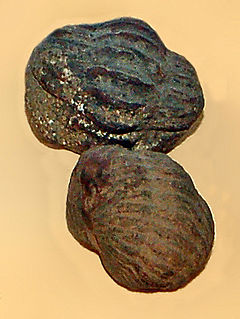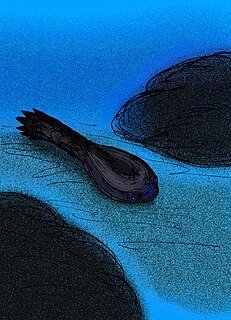 W
WAquilonifer spinosus is an extinct species of arthropod from the Silurian period. It is known from a single fossil specimen found in the Wenlock Series Lagerstätte of Herefordshire, England, in rocks about 430 million years old. The 1 cm long specimen is a stem-group mandibulate, not directly related to any living species. The many-legged, eyeless adult has ten unusual tethered appendages, interpreted as juveniles attached to the parent, in a unique form and previously unknown brooding behaviour.
 W
WThe Buildwas Formation, formerly called Wenlock Shale and Buildwas Beds, is a geologic formation in Shropshire, England. It preserves fossils dating back to the Silurian period. The formation is the defining formation of the Sheinwoodian age of the Wenlock epoch, the Middle Silurian.
 W
WThe Caledonian orogeny was a mountain-building era recorded in the northern parts of Ireland and Britain, the Scandinavian Mountains, Svalbard, eastern Greenland and parts of north-central Europe. The Caledonian orogeny encompasses events that occurred from the Ordovician to Early Devonian, roughly 490–390 million years ago (Ma). It was caused by the closure of the Iapetus Ocean when the continents and terranes of Laurentia, Baltica and Avalonia collided.
 W
WCalymene blumenbachii, sometimes erroneously spelled blumenbachi, is a species of trilobite discovered in the limestone quarries of the Wren's Nest in Dudley, England. Nicknamed the Dudley Bug or Dudley Locust by 18th-century quarrymen it became a symbol of the town and featured on the Dudley County Borough Council coat-of-arms. Calymene blumenbachii is commonly found in Silurian rocks and is thought to have lived in the shallow waters of the Silurian, in low-energy reefs. This particular species of Calymene is unique to the Wenlock series in England, and comes from the Wenlock Limestone Formation in Much Wenlock and the Wren's Nest in Dudley. These sites seem to yield trilobites more readily than any other areas on the Wenlock Edge, and the rock here is dark grey as opposed to yellowish or whitish as it appears on other parts of the Edge, just a few miles away, in Church Stretton and elsewhere. This suggests local changes in the environment in which the rock was deposited.
 W
WCalymene tristani is a trilobite belonging to the order Phacopida family Calymene. These trilobites lived in the Ordovician and Silurian periods.
 W
WCyathaspis is the type genus of the heterostracan order Cyathaspidiformes. Fossils are found in late Silurian strata in the Cunningham Creek Formation, New Brunswick, Canada and Europe, especially in the Downton Castle Sandstone of Great Britain and Gotland, Sweden. The living animal would have looked superficially like a tadpole, albeit covered in bony plates composed of the tissue aspidine, which is unique to heterostracan armor.
 W
WInvavita piratica is an extinct, parasitic species of tongue worm, provisionally assigned to the order Cephalobaenida, from Ludlow-aged England. Despite the common name, tongue worms are actually highly modified crustacean arthropods closely related to barnacles and copepods, not worms; the Pentastomida are obligate parasites. It possessed a head, a worm-like body, and two pairs of limbs.
 W
WThe Old Red Sandstone is an assemblage of rocks in the North Atlantic region largely of Devonian age. It extends in the east across Great Britain, Ireland and Norway, and in the west along the northeastern seaboard of North America. It also extends northwards into Greenland and Svalbard. These areas were a part of the ancient continent of Euramerica/Laurussia. In Britain it is a lithostratigraphic unit to which stratigraphers accord supergroup status and which is of considerable importance to early paleontology. For convenience the short version of the term, ORS is often used in literature on the subject. The term was coined to distinguish the sequence from the younger New Red Sandstone which also occurs widely throughout Britain.